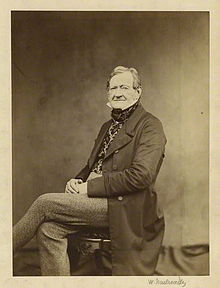William Mulready
William Mulready | |
|---|---|
 1860s albumen print portrait by Cundall, Downes & Co | |
| Born | 1 April 1786 |
| Died | 7 July 1863 (aged 77) Bayswater, London, England |
| Nationality | Irish |
William Mulready
Life and family
William Mulready was born in Ennis, County Clare. Early in his life, in 1792, the family moved to London, where he was able to get an education and was taught painting well enough so that he was accepted at the Royal Academy School at the age of fourteen.
In 1802, he married Elizabeth Varley (1784–1864), a landscape painter. She came from a family of established artists; her brothers included John Varley, friend of William Blake, Cornelius Varley, and William Fleetwood Varley.
Their three children, Paul Augustus (1805–1864), William (1805–1878), and Michael (1807–1889) also became artists. His relationship with his wife however deteriorated gradually over the years, which is detailed in papers stored at the library of the Victoria and Albert Museum. His strong Catholic beliefs prevented any chance of a divorce but they separated. He accused her of "bad conduct" but shied from providing details. In a letter to him in 1827 she blamed him entirely for the collapse of their marriage, suggesting cruelty, pederastic activities and adultery were the reasons,[2][3] writing that one of his pupils, Harriet Gouldsmith, had told her Malready "preferred her little finger" to his wife and children, and accusing him having "had taken a low boy to your bed, and turned one adrift at midnight, to seek one at the house of an unmarried man."[4][5]
His son, William Mulready Junior (1805–1878), lived in London and maintained a career of a portrait painter and picture restorer. He had five children (Ellen, Mary, Augustus Edwin, Henry William, and John[6]). They also were trained as artists, but not all of them pursued the artistic career: Henry William and John described themselves as 'house painters'.[6] Augustus Edwin Mulready (1844–1904) was the most successful of them and became known as a member of the Cranbrook Colony of artists.
Artistic career
In 1815 he became an Associate of the Royal Academy (A.R.A.) and R.A. in 1816.
In 1840, Mulready designed the illustrations for the
Death

He died at the age of 77 in Bayswater, London and is buried[14] in the nearby Kensal Green Cemetery where a monument to his memory was erected. The monument lies on the north side of the main path, midway between the entrance and the main chapel, and although not in the front line of graves it is easily spotted due to its unique form. The tomb was designed by Godfrey Sykes.[15]
See also
- Letter sheet
- List of people on stamps of Ireland
- Mulready stationery
References
- ^ . Dictionary of National Biography. London: Smith, Elder & Co. 1885–1900.
- ISBN 978-0-7864-2531-0.
- ^ Brian Reade, Sexual Heretics, London, 1970. p. 16
- ^ A Family History
- ^ Clairmont, Clara Mary Jane; Stocking, Marion Kingston The Clairmont correspondence: letters of Claire Clairmont, Charles Clairmont, and Fanny Imlay Godwin, Volume 1, Johns Hopkins University Press, 1995, p4.
- ^ a b Censuses 1861, 1871, 1881
- ^ Lamb, Charles (1807). Tales from Shakespear designed for the use of young persons. London: Thomas Hodgkins.
- ISBN 0801866405. Retrieved 11 October 2014.
- ^ mitchell, Sally (1988). Victorian Britain (Routledge Revivals): An Encyclopedia. p. 516.
- The Walters Art Museum.
- ^ Melville, Fred J, Postage Stamps in the Making, p71, Stanley Gibbons, 1916.
- ^ "Mulready stationery: Caricatures". The Queen's Own: Stamps That Changed the World. National Postal Museum. Retrieved 13 November 2020.
- ^ "Mulready Letter Sheets". Alphabetilately. Retrieved 9 November 2017.
- ^ "Mulready, William".
- ^ "Tomb of William Mulready, by Godfrey Sykes, Kensal Green Cemetery, London".
Further reading
- Stephens, Memorials of Mulready (London, 1867)
External links
- 69 artworks by or after William Mulready at the Art UK site
- Portrait of Mulready by Thomas Bridgford
- William Mulready
- William Mulready at Library of Congress, with 12 library catalogue records
 The Youthful Mariners., an engraving by Charles Fox of A Sailing Match (c. 1831) for The Amulet annual for 1833 with a poetical illustration by Letitia Elizabeth Landon.
The Youthful Mariners., an engraving by Charles Fox of A Sailing Match (c. 1831) for The Amulet annual for 1833 with a poetical illustration by Letitia Elizabeth Landon.
Artistic
- County Clare Library Famous Artist Born in Ennis
- Emory University's Shakespeare Illustrated Mulready's Seven Ages of Man
- National Portrait Gallery, London Portraits of, and by, William Mulready
- Tate Collection, UK Works by William Mulready
- Profile on Royal Academy of Arts Collections
Philatelic
- 1d Mulready Letter Sheet, 2d Mulready Letter Sheet
- Mulready Stationery Envelopes, Letter Sheets, Parodies and Exhibit Pages
- National Postal Museum, Washington, D.C. Stamps That Changed the World
Other
- Kensal Green Cemetery Tour Find the Mulready Tomb
